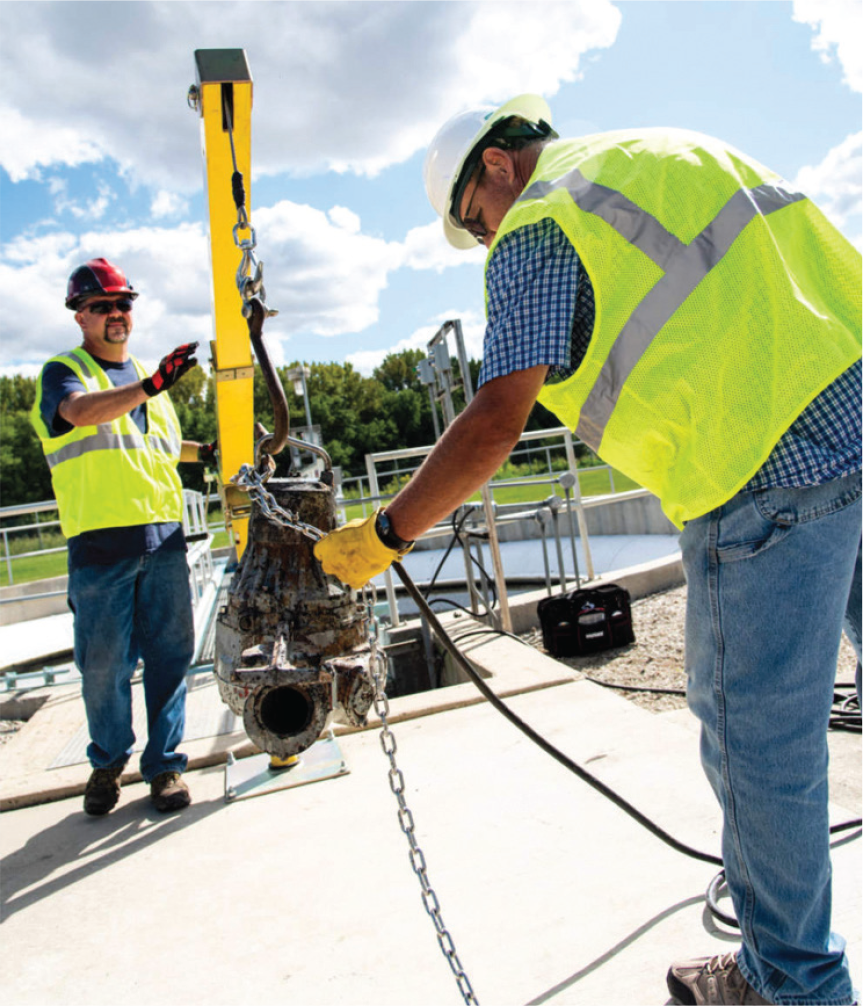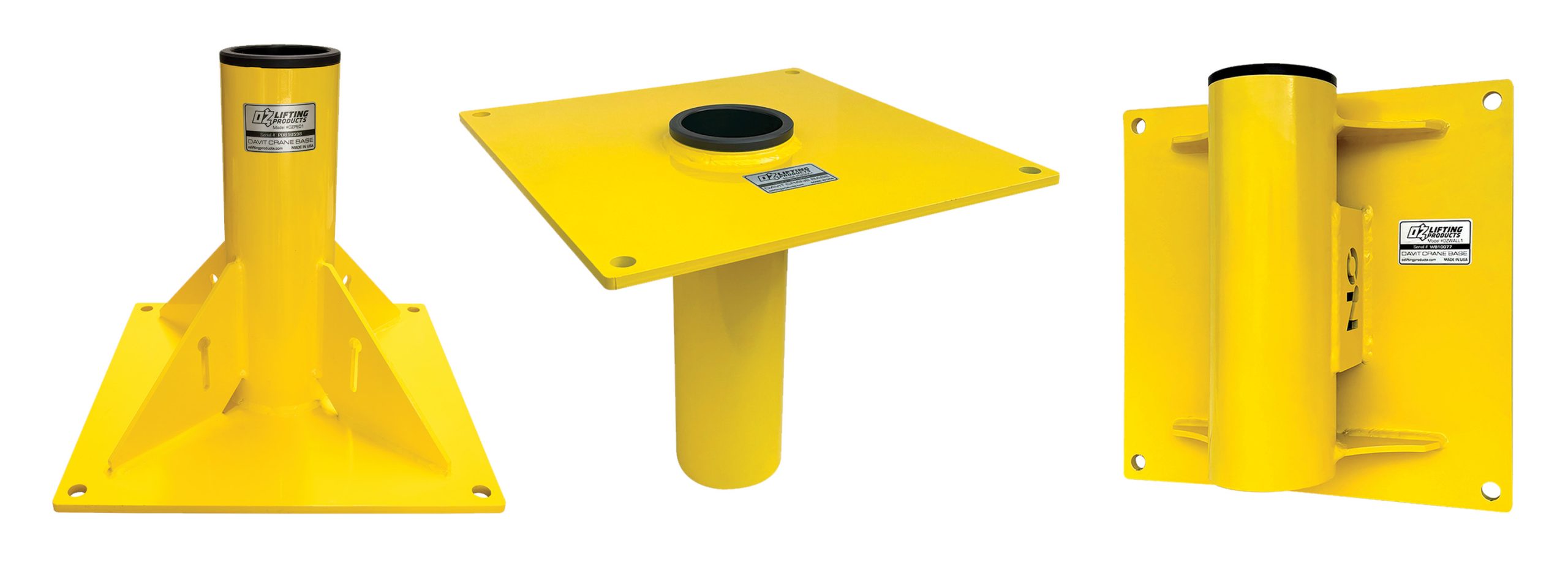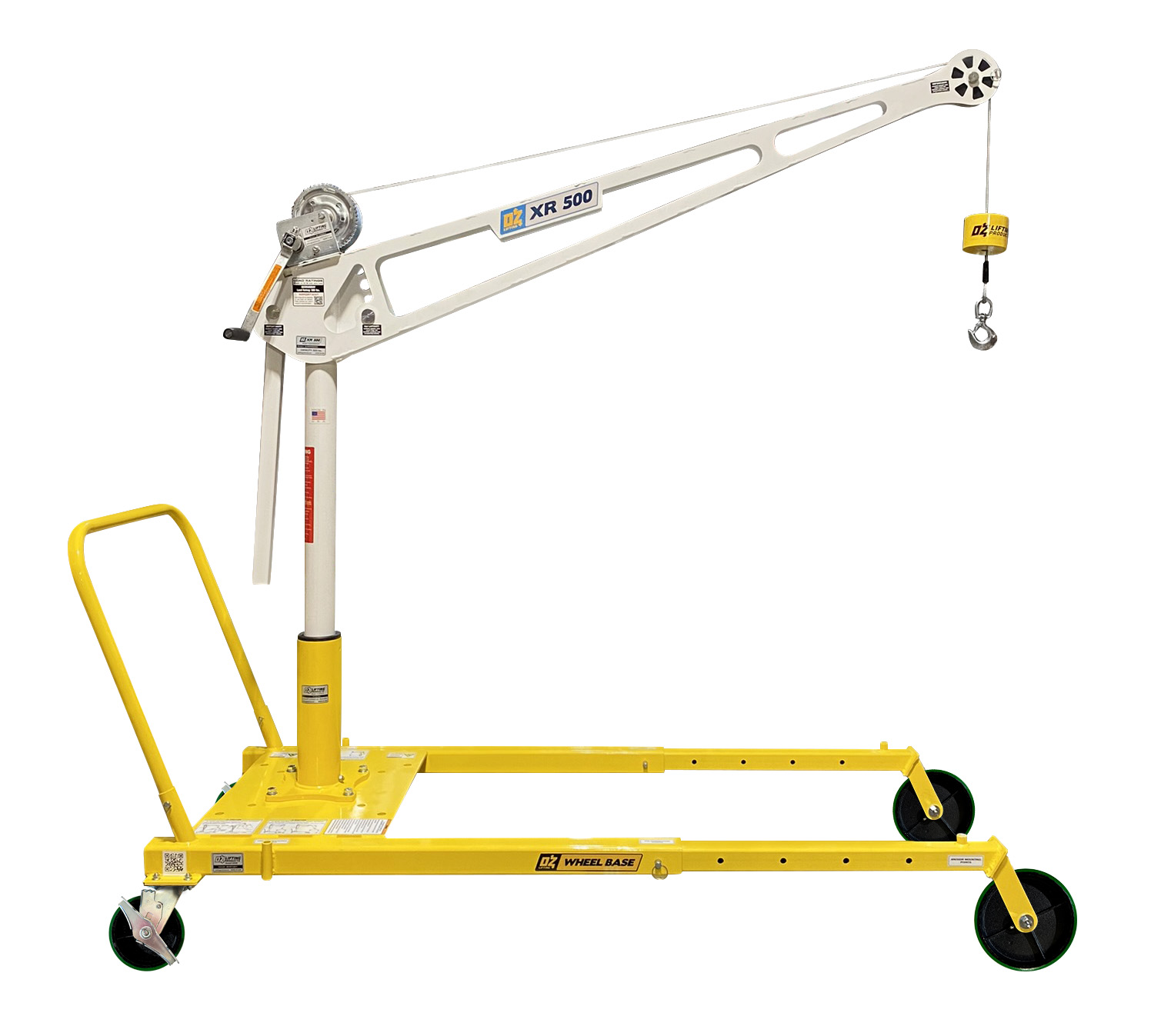The need to handle materials safely and efficiently is omnipresent in the wastewater sector, as it is in the myriad of end-user marketplaces that use cranes and other hardware to defy gravity. As sure as water takes the path of least resistance, loads will stay on the ground, or fall back to it, without lifting and rigging equipment, which is manufactured by companies like U.S.-based OZ Lifting Products LLC, of Winona, Minnesota.
OZ Lifting makes a series of products — cranes; manual and electric hoists; beam trolleys; winches; and components — all of which are widely used at the variety of sites found in the wastewater industry. However, it is perhaps best known for its davit cranes. A davit crane, remember, is different to a jib crane. The two products might be similar in appearance, but portable davit cranes are more cost effective and versatile, and are more popular with those sourcing lifting equipment for wastewater applications.
The concept isn’t new to wastewater; OZ Lifting first introduced its CompOZite (composite) davit to the Canadian market two decades ago. The popularity of such systems derives from ultra-portability and construction from advanced lightweight composite material. This material reduces the weight of the crane by 40% compared to traditional steel models, making it easier to transport and maneuver. In one recent application, an OZ Lifting distributor provided four CompOZite davit cranes and 80 pedestal bases, with the intention of mounting bases around the facility and moving the davits.

Despite this lighter weight, such davit cranes can boast a lifting capacity of 1,200 lbs. and require no tools for assembly. Additionally, they feature a 360-degree rotating arm and an adjustable boom with four positions for increased versatility in various work environments. The composite material construction also offers corrosion-resistance for enhanced durability; for the same reasons, stainless steel hoists, winches, and wire rope assemblies are also widely consumed by the sector.
Wastewater professionals typically source davit cranes, and other material handling technologies, from manufacturers’ distribution networks. OZ Lifting, for example, has coverage in every province from industrial distributors to lifting and rigging specialty dealers. Many are broad material handling houses, but there are Canadian distributors that specialize in wastewater solutions.
Challenging industry
As the entire supply chain reports, the water industry presents a number of challenges to material handling applications, including confined space, corrosive environments, heavy components, and extreme outdoor weather conditions — especially true here in Canada.
Perhaps the most obvious is confined space. As is the case in multiple industries, it is necessary to lift, lower, turn, and move loads where it is seemingly inconvenient to do so. In fact, where there is ample space, lots of headroom, and plenty of ground to install equipment, there is little or no need to handle materials there.
Many treatment plants have narrow spaces everywhere, such as those commonly found at pump stations or around digester tanks. Lifting gear needs to be maneuverable and compact to navigate these areas to complete maintenance or repairs. These workstations are often operated by only one or two people, so davit cranes, hoists, and winches need to be lightweight and portable. Fast and efficient set-up and ease of use are prerequisites. With the composite davit crane referenced above, a ratchet screw jack adjusts the boom under load giving the user infinite range of lift.
The environment around such facilities is inherently corrosive. Further, wastewater can be abrasive and contain harmful chemicals and biohazards. Material handling equipment must be resistant to these elements to ensure durability and safety, not just at the first time of use, but in repeated application. Consider the difference in environment between a sewage works and an indoor warehouse, and the different demands each one places on material handling equipment.
Another challenge is the heavy components found at wastewater sites. Buying decision makers working in water treatment often approach their local material handling dealers with a need to lift, remove, or install heavy pumps, pipes, valves, and other hardware. Lifting and transporting such loads requires robust handling systems; dropping a pump can be costly and dangerous and will present an even bigger problem trying to retrieve it safely in an unplanned lift.
In all parts of the world, wastewater facilities are often exposed to the elements, which means that particular attention has to be paid to geographical location and the extremes it might present from high summer to the middle of winter. Wastewater treatment facilities are often located near bodies of water like lakes, rivers, or even coasts, so moisture, humidity, and saltwater corrosion are of concern. Durable, corrosive-resistant coatings and materials are used to protect the apparatus, including cranes, that needs to work there.
This is where stainless steel and composite materials come into play. Unlike an indoor, temperature-controlled environment, Canada experiences a wide range of extremes, from scorching summers to frigid, snowy winters — but the equipment needs to be able to operate, regardless.
Water pressure
In conclusion, only once the load, environment, and all other challenges have been considered, can a wastewater professional, a lifting equipment manufacturer, and its representatives, set about choosing the right crane, hoist, beam trolley, winch, and supporting components.
Using the appropriate equipment reduces wear and tear, minimizes unnecessary stress on the products, extends their lifespan, and reduces replacement costs. On the other hand, using the wrong lifting equipment can lead to accidents and injuries. Lifting a heavy object with an under-capacity hoist could result in equipment failure, dropping the load, and serious incident. Having the right tools for the job streamlines the process and contributes to overall operational efficiency, lowering total operational expense.
Despite the numerous and unique challenges presented by the wastewater industry, it is possible to achieve safe and efficient material handling, even in the most confined space, in the middle of winter, beside saltwater, when the pressure is on. Are you ready for your next lifting operation?
Base line
Throughout a wastewater facility, there might be a need for permanent, static, or frequently moved davit cranes. Regardless, it is necessary to choose an appropriate base; there are three main options (each one comes with a mounting template), plus OZ Lifting’s new wheel base:
- Pedestal: commonly bolted to the floor in a facility. Users just mount the base where they need to make a lift and move the crane from base to base.
- Socket: used in an area where the installer will pour cement around the base to keep the surface area flat and create high mounting strength.
- Wall-mount: allows a davit crane to be attached to the wall of a facility to save floorspace, perhaps on a production line or at a workstation.
- Wheel base: allows users to move the crane to various points within a facility; the applications are limitless. The main benefit is that users do not have to permanently mount a base at the pick location. The wheel base is adjustable with four different length positions. It measures from 56.57” to 77.57” long; 32.44” wide; and 36.87” high. It weighs 140 lbs. when fully assembled, without a crane’s pedestal base, so total weight will depend on the davit being used. The wheel base features a patented floor anchoring system, which allows the davit to rotate 360 degrees, even when under load.
Note that without the correct base, users will not be able to use a davit crane.

Industry ingress
OZ Lifting has raised its profile in the wastewater sector through a number of appearances at the Water Environment Federation’s Technical Exhibition & Conference (WEFTEC), which takes place this year in New Orleans; a program of seminars spans October 5-9, with the exhibition held on the final three days. OZ returns having exhibited on three prior occasions either side of the pandemic.
In addition to the composite davit cranes, also on show will be the Tele-Pro davit crane. Available in 500 lbs., 1,200 lbs., and 2,500 lbs. capacities, it allows users to leverage the benefits of other lifting technologies in its range, while telescoping the boom in and out under load. The Alumi-Lite series of ultra-portable davit cranes, meanwhile, available in 500 lbs. and 1,000 lbs. capacities, is an aluminum series targeted specifically at applications where portability is beneficial, including those in wastewater and wider water work. The CompOZite Elite carbon fiber models will also be on show, as will Longreach davits. Attendees should also look out for the new wheel base, which allows users to move their cranes to various points within a facility.

OZ Lifting will be represented at WEFTEC by Steve Napieralski, president; Richard Miller, sales manager; Parker Hale, inside sales specialist; and Ashley Blum, marketing manager, all of whom will network with engineers, operators, and decision-makers in the water treatment industry.